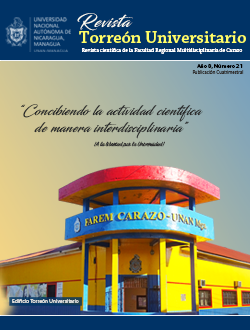An overview of Carazo department from the regional studies
DOI:
https://doi.org/10.5377/torreon.v8i21.8855Keywords:
historical region, ethnography, cultural ecology, integration and articulationAbstract
Located in the recent Nicaraguan regional historiography, promoted by the National Autonomous University of Nicaragua, Managua (UNAN-Managua) since the 1980s, this article aims to demonstrate that historical regions have integration and articulation dynamics that do not necessarily they correspond to the administrative political divisions of the territory. To explain this dynamic, the method of cultural ecology of anthropologist Julian Steward (1955) has been used, which proposes to understand the regions from its cultural nucleus, that is, the adaptation and interaction of man with his environment; Of course, ethnographic work has been fundamental. The results reveal that Carazo has four internal historical regions. Therefore, it could be concluded, among other things that both the political and regional divisions coexist without opposing each other, but regional understanding stands out as a possibility of shortening the center-periphery gap.
Downloads
Downloads
Published
How to Cite
Issue
Section
License
Los autores que publican en esta revista están de acuerdo con los siguientes términos.
- El autor o los autores de los artículos, ensayos o investigaciones conceden a la Universidad Nacional Autónoma de Nicaragua, Managua (UNAN-Managua) los derechos de edición (copyright) del trabajo enviado, por consiguiente la Universidad cuenta con el derecho exclusivo para publicar el artículo durante el periodo completo de los derechos de autor.
- Estos derechos de autor/ autores autorizan a la Revista Torreón Universitario y a la Universidad editar y divulgar/publicar el artículo en dicha Revista, incluyendo reproducción impresa y electrónica, el almacenamiento, recuperación y cualquier otro tipo de publicación, y fuentes de información secundaria como servicios de resúmenes y bases de datos, así mismo la facultan a proteger el artículo contra el uso no autorizado para su difusión por medios impresos o electrónicos (PDF, HTML, EPUB, XML u otros).
Licencia para el uso del contenido
La revista hace uso de la Licencia Creative Commons Atribución-NoComercial-SinDerivar 4.0 Internacional.
Bajo esta declaración:

Este revista está sujeta a una licencia de Creative Commons Reconocimiento-NoComercial-SinObraDerivada 4.0 Internacional. Puede ser copiada, distribuida y transmitida públicamente siempre y cuando se cite al autor y la fuente (Revista Torreón Universitario), no debe modificarse ni utilizarse con ningún fin comercial. La licencia completa se puede consultar en http://creativecommons.org/licenses/by-nc-nd/4.0/.

